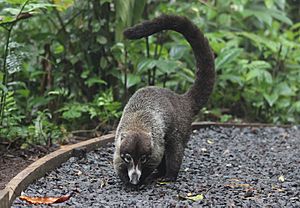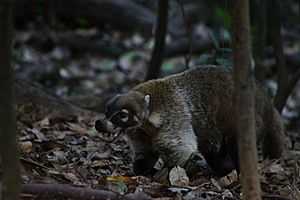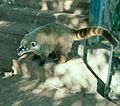Coati facts for kids
Quick facts for kids Coati |
|
|---|---|
 |
|
| White-nosed coati (Nasua narica) | |
| Scientific classification | |
| Kingdom: | |
| Phylum: | |
| Class: | |
| Order: | |
| Family: | |
| Genus: |
Nasua and Nasuella
|
 |
|
| Range map | |
The coati, sometimes called a coati-mundi, is a fascinating mammal. It belongs to the raccoon family and is found in South America, Central America, and parts of North America. These animals are mostly active during the day, using their long, flexible noses to explore their surroundings. The name "coati" comes from the Tupi language of Brazil.
Contents
Amazing Coati Features
Coatis are about the size of a large house cat. They can be 33 to 69 centimeters (13 to 27 inches) long, not counting their tail. Their tail can be just as long as their body! Coatis stand about 30 centimeters (12 inches) tall at the shoulder. They usually weigh between 2 and 8 kilograms (4 and 18 pounds). Male coatis can be almost twice as big as females. They also have large, sharp canine teeth.
All coatis have a thin head with a long, flexible nose that points slightly upwards. They have small ears and dark feet. Their long tail helps them balance and send signals to other coatis.
Ring-tailed coatis have light brown or black fur. Their belly is lighter, and most have a tail with white rings. These rings can be very clear, like a raccoon's, or very faint. Coatis often hold their tail straight up. This helps groups of coatis stay together in tall plants.
Coatis have paws like bears and raccoons. They walk on the soles of their feet, just like humans. Their claws cannot be pulled back into their paws. Coatis are also very flexible. Their ankles can twist more than 180 degrees! This allows them to climb down trees headfirst.
Their snout looks a bit like a pig's nose. It is super flexible and can turn up to 60 degrees in any direction. Coatis use their noses to push things and rub parts of their body. They also have white markings around their eyes, on their ears, and on their snout.
Coatis have strong legs for climbing and digging. They are known for being smart, just like raccoons. They like to sleep or rest in high places, like in the tops of rainforest trees. They build simple nests for sleeping.
Where Coatis Live
Coatis live in many different places. They can be found in hot, dry areas or in humid Amazonian rainforests. They even live on cold Andean mountain slopes. Their home range stretches from the southwestern United States (in Arizona, New Mexico, and Texas) all the way to northern Uruguay.
How Long Coatis Live
In the wild, coatis usually live for about seven to eight years. But if they live in zoos or with people, they can live much longer, sometimes up to 15 or 16 years!
What Coatis Eat
Coatis are omnivores, meaning they eat both plants and animals. Their main diet includes small creatures found in the ground, like invertebrates (such as tarantulas), and fruit. They also eat small animals like lizards, rodents, small birds, and bird eggs. Their excellent sense of smell helps them find these hidden meals. They use their noses and paws to dig up food, much like a pig.
Coati Behavior
Most of what we know about coati behavior comes from the Nasua species. Unlike most members of the raccoon family, coatis are mainly active during the day. Female coatis and young males (up to two years old) live in groups. These groups, called bands, can have four to 25 coatis. They travel through their territory, looking for food on the ground or in the trees.
Older male coatis (over two years old) usually live alone. They only join the female groups during the breeding season.
If a coati feels threatened, it can be a fierce fighter. Their strong jaws, sharp teeth, and fast scratching paws make it hard for predators like dogs or jaguars to catch them.
Coatis communicate using chirping, snorting, or grunting sounds. Different chirps can show happiness during grooming or anger after a fight. Snorting while digging, along with a tail held straight up, can mean they are claiming their territory or food.
Coatis also use special body movements to send messages. For example, hiding their nose between their front paws means they are giving up. Lowering their head, showing their teeth, and jumping at an enemy means they are ready to fight. Coatis recognize each other by how they look, their voices, and their unique smells. They have special scent glands on their necks and bellies that make their smell stronger.
Some coatis in Panama rub their fur with sticky resin from trees. Scientists are not sure why they do this. It might be to keep insects away, prevent fungus, or even to mark their scent.
Coati Babies
Coatis usually have babies when the rainy season begins. This is when there is the most food, especially fruit. This can happen between January and March in some places, or between October and February in others. During this time, an adult male joins a group of females and young coatis.
Pregnant females leave the group to build a nest. They might build it in a tree or in a rocky spot. After about 11 weeks, they give birth to three to seven babies, called kits. About six weeks after the babies are born, the mother and her young rejoin the group. Females can have babies when they are two years old, while males are ready to mate at three years old.
Who Hunts Coatis?
Coatis have several natural predators. These include jaguarundis, boa constrictors, foxes, dogs, tayras, ocelots, and jaguars. Large birds of prey, like ornate hawk-eagles and harpy eagles, also hunt them. Even White-headed capuchin monkeys sometimes hunt coati pups.
Coatis as Pets
Coatis are sometimes kept as pets in parts of North, Central, and South America. However, they are wild animals and can be challenging to control or train. They behave very differently from a pet dog.
Ideally, pet coatis should have a large outdoor space. They also need a coati-proof room inside the house or another warm place, especially in cold weather. They can roam freely in a house, but they need careful watching.
It is possible to train coatis to use a litter box or a specific toilet area. If they can't be trained, they often choose one spot as their "bathroom," where a litter pan can be placed.
Coatis usually need vaccines for diseases like distemper, similar to dogs and cats. They also need a rabies vaccine. Like other pets, they can be spayed or neutered.
Images for kids
-
White-nosed coati at Tikal, Guatemala
-
Coati foraging in Playa del Carmen, Mexico
-
South American coati looking for food in Iguazú National Park of Argentina
-
Pair of South American coatis at Xel-ha aquatic theme park in Quintana Roo, Mexico
-
White-nosed coati on Mt. Hopkins near Madera Canyon (Arizona)
-
A coati feeding on fruit at a monkey sanctuary (Paseo de los Monos) in the Amazon of Puyo, Ecuador.












